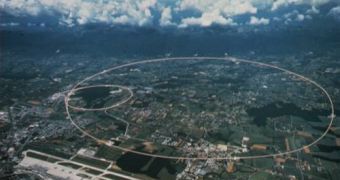A particle accelerator is a device that uses electric fields to propel electrically charged particles to high speeds and to contain them. An ordinary CRT television set is a simple form of accelerator. There are two basic types: linear (in a straight-line) accelerators and circular accelerators.
In a linear accelerator (linac), particles are accelerated in a straight line with a target of interest at one end, and are very widely used. They are also used to provide an initial low-energy kick to particles before they are injected into circular accelerators. The longest linac in the world is an electron-positron collider, the Stanford Linear Accelerator, SLAC, which is 3 km (2 miles) long.
In the circular accelerator, particles move in a circle until they reach sufficient energy. The particle track is typically bent into a circle using electromagnets. The advantages of circular accelerators over linear accelerators is that the ring topology allows continuous acceleration, as the particle can transit indefinitely, as it is relatively smaller than a linear accelerator of comparable power (a linac would have to be extremely long to have the equivalent power of a circular accelerator).
The world's largest particle accelerator is the CERN's1 LHC, or Large Hadron Collidor, presented this month in Geneva, Switzerland. CERN stands for European Center for Nuclear Research (Centre Europeen pour la Recherche Nucleaire, in French)
This magnet was built to answer the most fundamental questions in physics, and is part of a series of 392 quadripole magnets designed to guide and focus the beams, which will ensure that the beams are kept on track all along their trajectory through the tunnel by controlling the beams' millimetric dimension all the way along their trajectory.
It is assembled at the CERN in a tunnel which has a circumference of 27 km and is buried 100 meters beneath the Franco-Swiss border. It is composed of 1700 large magnets and it also includes a significant quantity of corrective magnets and requires the largest cryogenic infrastructure ever created using superfluid helium at -271?C, a temperature lower than that of interstellar space.
The final installation of the LHC will be completed in mid-2007, and start-up is planned for November 2007.

 14 DAY TRIAL //
14 DAY TRIAL //